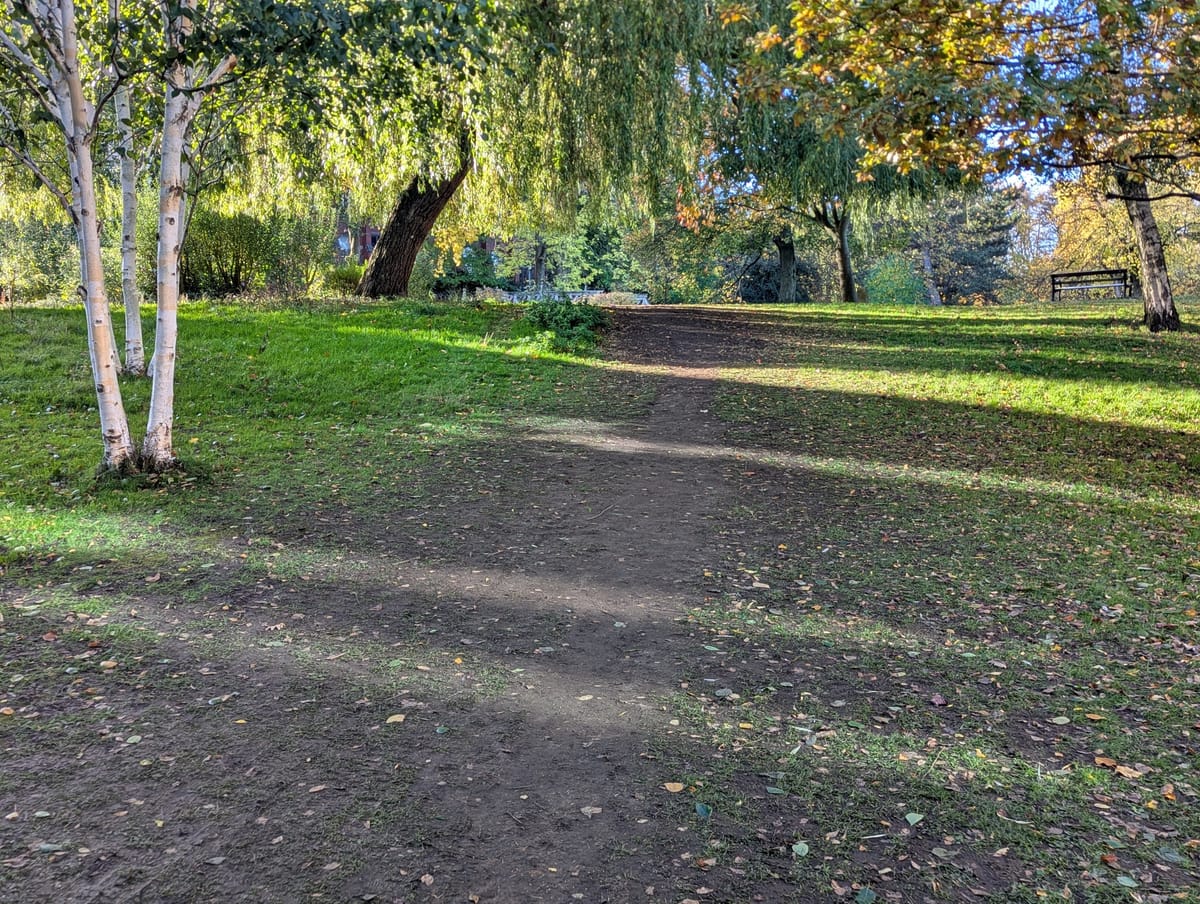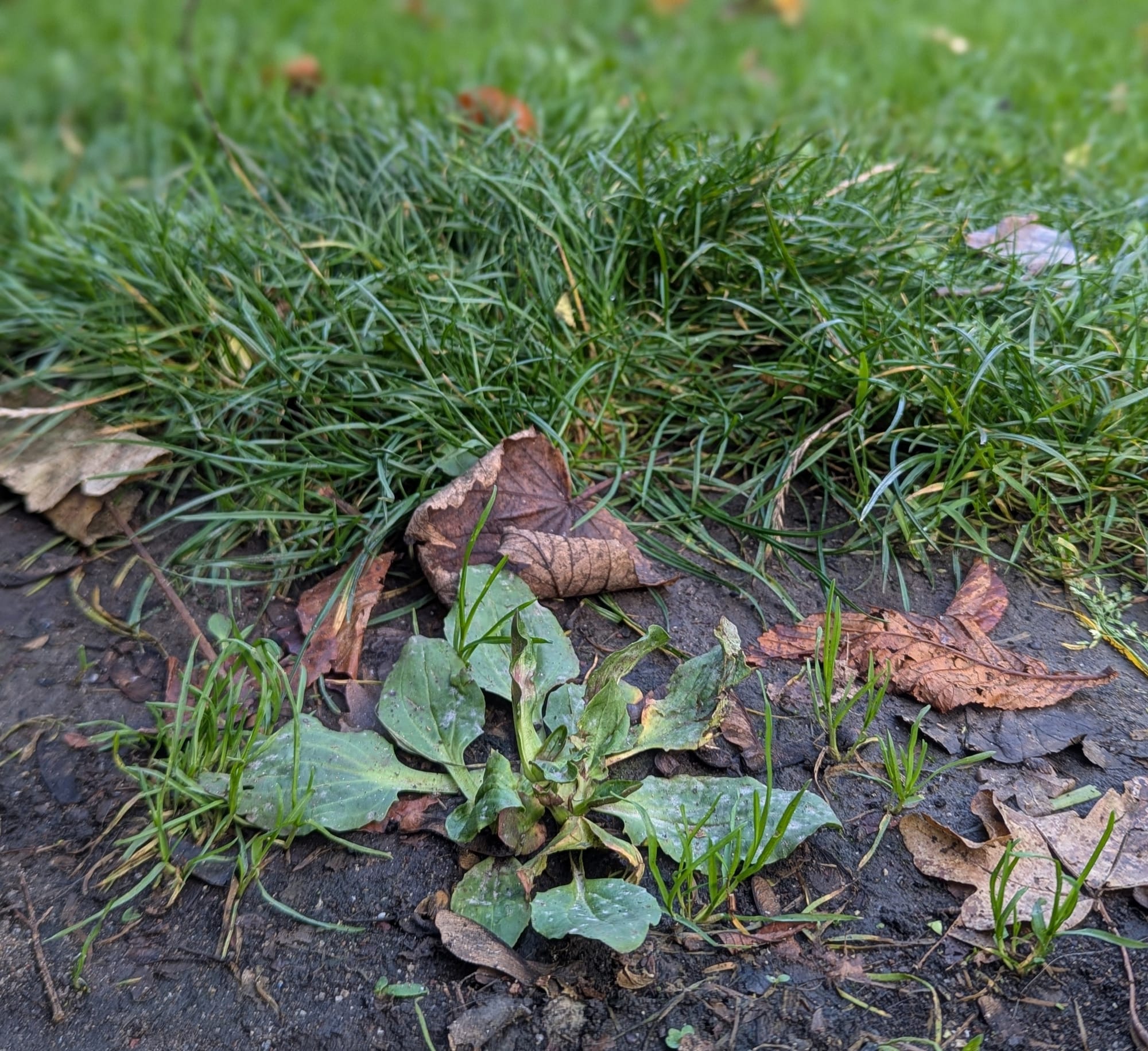The edges of desire: on black walnuts and plantains
Notes from Marble Hill Park, Twickenham

The surface is hard, compacted by the tread of many feet. Rosettes of broadleaf plantain cluster at the borders; a line of bare earth runs down the middle.
This path wasn’t laid by the gardeners: it’s a desire path. Visitors have created it simply by walking here, passing under the huge black walnut tree and dispersing onto the lawn in front of the stately home.
In Virginia and North Carolina the historic abundance of the black walnut, juglans nigra, is attested by numerous place names: towns, villages, creeks, a plantation built with enslaved labour. And it was from this area that Thomas Harriot—principal boffin at the very first English colony on Roanoke Island—is thought to have introduced the black walnut to Britain in the 1580s. It now thrives on both sides of the Atlantic: it’s afflicted by European canker, but helped by other imported diseases that are decimating competing species.[1]
Although Roanoke ended in death and disaster for its human participants, one early English colonist flourished: the broadleaf plantain, plantago major, inadvertently carried to America by the settlers. Native Americans noticed it springing up wherever the newcomers went, along with smallpox. They called it “white man’s footprint”.[2]
Natural historians, notably fond of irony, call all of this traffic “the Columbian Exchange”.
Black walnut and broadleaf plantain are both pioneer species. Wind-pollinated, dispersing thousands of seeds, plantains establish themselves quickly, before competitors arrive, and hang on. Walnuts, however, also have anti-social tendencies: they’re allelopathic, releasing a toxin that damages other plants. According to Pliny the Elder, the very shadow of the walnut tree is “noxious to everything that grows in its vicinity.”[3]
But the gigantic tree in front of me, believed to be the largest juglans nigra specimen in Britain, obviously hasn’t troubled the plantains.[4] This environment suits them. Notoriously resistant to trampling, they survive on the edges of well-trodden paths, where other plants would be crushed.

I suppose there must have been a time when desire paths were the only kind of paths. Ever since the Ancient Egyptians, ornamental gardens have incorporated routes based on purposeful design rather than instinctive preference,[5] but people will always go where they aren’t supposed to go. Some desire paths, like this one, mark routes between places that would otherwise be unconnected. Others cut the corner between two official paths, forming a triangle.
Speaking of desire, Marble Hill House and its gardens were funded by gifts from George II to his mistress, Henrietta Howard, including an £8,000 shareholding in the South Sea Company. Built in the fashionable Palladian style, the design spread far and wide. Its influence can be traced in countless American plantation houses—including many bearing the names Black Walnut, Walnut Hall, or Walnut Grove.[6]
Although ordinary investors had been ruined when South Sea Company stock collapsed in 1720, the king’s interests were protected. And until the 1730s the Company maintained its core business: the transatlantic shipment of an annual quota of 4,800 human beings for sale.[7]
I wonder if this is an age of undesired paths. I think about the Noble Eightfold Path, and the cessation of all desire. Sometimes I try to imagine the facial expression of Hernán Cortés, that notable protagonist of the Columbian Exchange, as he explained to one of Moctezuma’s officials: “I and my companions suffer from a malady of the heart, a sickness that can only be cured by gold.”[8]
Under walnuts, between plantains, bare, lifeless ground. A deathly passage. Where enough of us walk, nothing can grow.
On the history of the black walnut, see Hadfield, M., ‘The black walnut’, Quarterly Journal of Forestry LVVI 4, 220-222 (1977), although other sources suggest a later date for introduction to Europe: for example, Nicolescu, V. et al, ‘A review of black walnut (juglans nigra L.) ecology and management in Europe’, Trees 34: 1087-1112 (2020) ↩︎
Kimmerer, R. W., gives this name in Braiding Sweetgrass (Milkweed 2013). ↩︎
Pliny, The Natural History XVII. 18 (tr. Bostock, J. and Riley, H. T., Taylor & Francis 1855). The allelopathy of walnut trees is widely attested but some recent studies have cast doubt on its extent: see Nicolescu et al. ↩︎
English Heritage, 'Eleven iconic trees' ↩︎
Daines, A., ‘Egyptian Gardens’, in Studia Antiqua, vol 6 no. 1, 15-25 (2008) ↩︎
English Heritage, "History of Marble Hill" ; Dresser, M. and Hann, A. (eds.), Slavery and the British Country House (English Heritage 2013); and English Heritage, "Georgians: Architecture". See also, for example Open Durham, "Walnut Hall - Willie P. Mangum House"; National Park Service, "National Register of Historic Places Inventory - Nomination Form: Walnut Grove"; Turley, C.E. and Harley, J.E., "National Register of Historic Places Inventory Nomination Form: Walnut Grove" (State of West Virginia, 1976) ↩︎
Paul, H., ‘The South Sea Company’s slaving activities’, Papers of the EHS Conference 2004 ↩︎
Lopez de Gomara, La Conquista de México (1552), quoted in Sanchez, D. S., ‘Hernán Cortés y la enfermedad del oro’, A&H (6 September 2018) ↩︎
Images are unfortunately from Weston Park, Sheffield: not Marble Hill. Photos by the author.
This is an edited version of an essay shortlisted for the Philip Hoare Prize in September 2025.